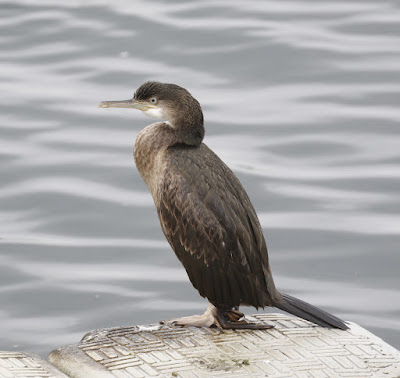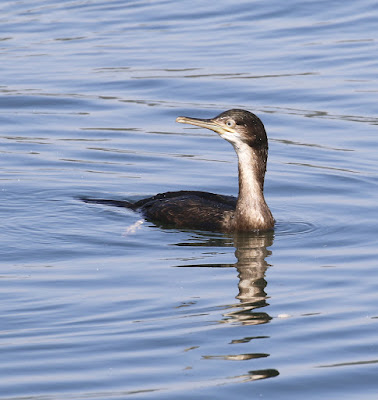Yes OK. I know. Now let's get all the smutty innuendos out of the way first and then we can all calm down and move on.
I could say it's the first Shag I have had at Farmoor since 2011
I could say it's only the second Shag I have had in Oxfordshire
I could say I had nine Shags before ten o' clock
That's better!
Now I will get on with recounting the tale of a remarkable event at Farmoor Reservoir on this August Bank Holiday.
News came through on Sunday lunchtime that six Shags had been found by Stuart at Farmoor Reservoir, Oxfordshire.
Many of Oxonbirds finest made their way to the reservoir that afternoon or evening, to witness a surely unique event. The last Shag to visit Farmoor was a single individual in September 2011. It is a rare species in Oxfordshire as they are far more maritime than the Cormorants which are present at Farmoor all year round. For no less than six to arrive together was hard to believe. It was even harder to comprehend that, as various Oxonbirders watched them, the number rose to nine and then eventually to eleven. It was totally unprecedented.
I could not make it to Farmoor that day as prior commitments prevented me leaving the house, so it was not until Bank Holiday Monday that I made my way to Farmoor to be there for when the gates first opened at eight o clock. Here I met Andy and Dai and after some deliberation we picked out one of the Shags sat on a valve tower roof in the centre of Farmoor 2, the larger basin, and a number of others perched on a pontoon away over towards the far side of Farmoor 2.
Dai headed off to check the Causeway whilst Andy and myself embarked on the long trudge around Farmoor 2 to position ourselves opposite the distant pontoon where most of the Shags were perched.
The weather was, as forecast, sunny and calm and it was already, at this early hour, getting warm.The water of the reservoir was a mirror of blue, flat calm with not a trace of wind to ripple its surface. Coots and Mallards were, as per usual, feeding close to the shoreline that now sported an unattractive bilious green frieze of slime at the concrete edge, liberally sprinkled with countless moulted feathers and the occasional long dead trout. A typical late summer day at Farmoor. Further out a flock of no less than fifteen Little Grebes floated like plump and rounded sponges that had been cast on the flat calm waters. Some of these tiny grebes must be newly arrived as a number were still to lose their summer breeding plumage.
 |
| Little Grebes-in summer and winter plumage |
We walked onwards to come level and opposite the pontoon and soon picked out eight Shags loafing on the pontoon, scattered amongst their close relatives, Cormorants. Observing the two species side by side it was easy to discern the size difference and also the different profile of the Shags compared to their larger cousin. Both species looked uncomfortably reptilian but the Shags possess a delicate appearance and gentler demeanour due to their slighter build and thinner bill compared to the larger, more ungainly Cormorants. We sat and watched the Shags, noting they were all juvenile birds, drab brown and unexceptional and for three hours they did precisely nothing. And why not, sat safe and secure, offshore on their pontoon in the sun. The three hour vigil was not, however without some other bird action to keep us mildly interested.
 |
| Grey Heron and Shag |
Peter joined us, as did Mark, both never having had, sorry, seen a Shag in Oxfordshire.
Peter soon left to go to Somerset to see a Moorland Dragonfly, whatever that may be while we remained, but eventually we too tired of watching the equivalent of paint drying and made our way back to the cafe for a reviving cuppa. Sat outside on the table chatting about this and that with Andy was very pleasant but I was keen to get back to the pontoon in the hope the Shags might be doing something that would involve them taking to the water and coming closer to the reservoir edge for a photograph opportunity. To save my legs I drove around from the reservoir car park to Lower Whitley Farm, left the car there, slipped through the footpath gate and up the reservoir bank, which brought me out just a hundred metres from the pontoon.
Sadly and frustratingly I found little had changed. True, one Shag was now in the water but it was just messing around the pontoon and no nearer to me than before whilst the others were asleep or idly scratching their heads with their outlandish sized webbed feet. A process incidentally which was carried out delicately and with much deliberation, took a very long time and which they seemed to very much enjoy! I sat and waited but it was not going to happen soon, if at all. I found another Black Tern far out in the middle of the reservoir but it did not hang around and just like the one earlier moved on through. I guess in this fine weather it made sense to take as much advantage as possible of the benign conditions as it still had a long way to go to its winter home in tropical Africa.
It was now midday and very hot, uncomfortably so, and then my phone rang. It was Andy.
'How are you getting on with the Shags over there?' He enquired.
'Not very well. They are still doing nothing.'
'You might like to know there is a Shag on the pontoon opposite the cafe and its giving great views'.
'Cheers, I am on my way'.
I went back to the car and drove the short distance back to reservoir car park and ran up the ramp to join Andy. Sure enough, there was a juvenile Shag perched on a pontoon just a few metres across the waters of the small marina. We took many images and the Shag idled its time away on the pontoon, curling up one of its webbed feet on the pontoon, in what was for a Shag presumably a comfortable resting position. Various yachtsmen and fishermen came very close to it as they launched boats from the pontoon but it was hardly alarmed by their presence, just craning its neck in curiosity and eventually it took to the water and commenced to fish, swimming further out into the reservoir.
 |
| Shag-one of the nine immature birds present |
Lunch beckoned, so a baked potato and chips from the cafe served to keep body and soul together and, suitably re-energised and rested, I left Andy and decided to walk the circumference of Farmoor 2 once again. It was insane in the heat of the day but I was convinced that sooner or later if I persisted I was going to manage to get a close up image of a Shag swimming and fishing in the water. I had no reason to be this optimistic but hope springs eternal!. On the way I found the two late hatched Mallard ducklings now looking much more adult as they revelled in the green slimy waters.
 |
| Young Mallards |
I walked slowly onwards and on getting back to the pontoon there seemed little change in the status quo. A couple of Cormorants, reasonably close to the shoreline set my pulse almost racing but that was it. I stood by the reservoir edge and then a slim shape surfaced and at first, wet and with feathers sleeked looked like one of the many Great crested Grebes currently present in this part of the reservoir.
 |
| Great crested Grebe still in summer plumage |
Low in the water, serpentine in movement, its back almost awash and its long tail extended flat on the water it was hard to discern any detail. I could see its bill was long and pointed but there was no white on its head or flanks and it was, as I had hoped, a Shag, doing precisely what I wanted it to do. It was clearly aware of my presence but showed no concern and as I watched it swimming around and photographed it, the Shag came ever closer until it was but a few metres away from me.
A fantastic result and justification for my aching limbs and sore feet. Apart from its rarity here, there was nothing else remarkable, its plumage being overall various shades of dull brown with a white chin and throat by way of variety.
I watched it fishing before it swam further out into the blue waters of the reservoir, now thankfully being ruffled by a slight breeze. I had got what I wanted and it really was time for home.The hours had passed un-noticed and to my amazement I found it was already three in the afternoon. I carried on around the reservoir finding another pair of Egyptian Geese. So, they have now multiplied from two birds to four.
 |
| Egyptian Geese |
A quick stop to admire a Mute Swan feeding with its head and orange bill clearly visible under the clear water of the shallows as it fed and then it was time to head for the Causeway and home.Two Yellow Wagtails ran before me on the concrete perimeter track.Their cheery calls echoing my mood.
It had been another good day at Farmoor Reservoir

























































